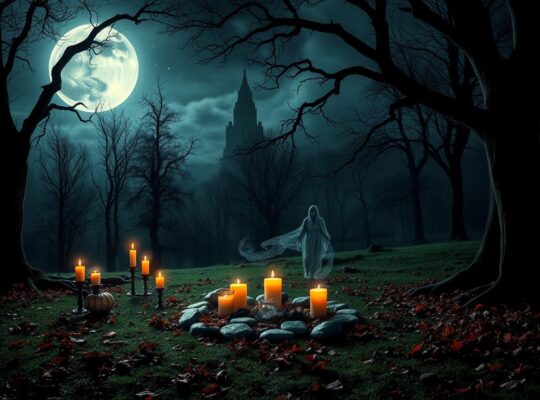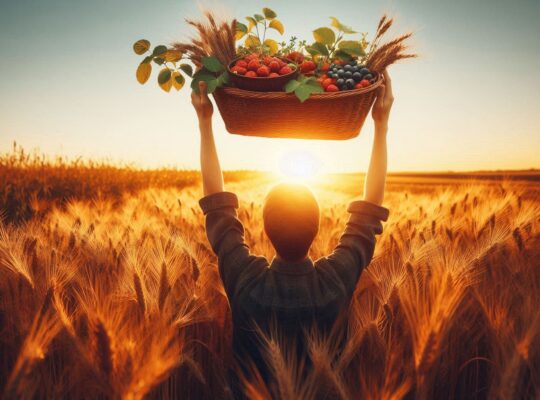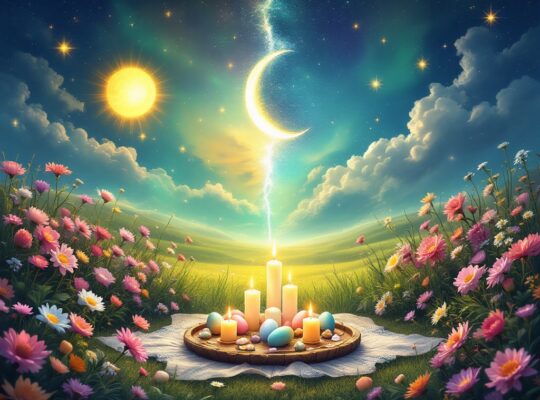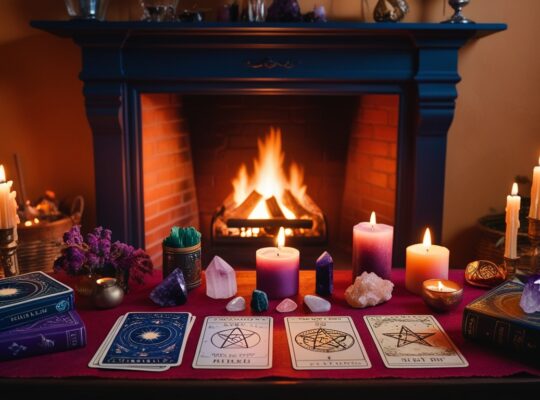Yule’s Healing Light: Celebrating Winter Solstice Magic
As darkness reaches its longest point and cold winds whisper outside, the Wheel of the Year turns to welcome Yule, the Winter Solstice celebration. This special time marks the rebirth of the sun and the gradual return of light after the year’s longest night. Yule invites us to find warmth in community, hope in darkness, and the quiet magic that winter offers our spirits. In this guide, we’ll explore simple ways to bring Yule’s nurturing energy into your life with rituals that honor both the darkness and the returning light.
When Yule’s Light Returns
Yule occurs annually around December 21st in the Northern Hemisphere. In 2025, we’ll celebrate on Sunday, December 21st. This meaningful holiday marks the Winter Solstice—the shortest day and longest night of the year, when darkness reaches its peak before slowly giving way to increasing light.
After Samhain’s thin veil between worlds in late October, Yule brings us to the depth of winter—a time of rest, reflection, and the promise that light always returns. Traditional celebrations honored this pivot point with evergreens, fires, feasts, and community gatherings that brought warmth and hope during winter’s coldest days.
The name “Yule” comes from ancient Norse traditions celebrating this turning point in the year’s cycle. Many modern Christmas traditions—like decorating trees, hanging wreaths, giving gifts, and lighting candles—have roots in these ancient Yule customs that helped our ancestors find joy during winter’s darkness.
Yule teaches us about the balance of darkness and light—that both are necessary parts of life’s cycle. This makes it a perfect time for healing practices that honor rest, reflection, and the quiet rebirth that happens in winter’s stillness.
Ancient Wisdom of Yule
For thousands of years, people worldwide have marked the Winter Solstice with ceremonies honoring the sun’s rebirth and the return of light. Our ancestors understood that this moment marked an important transition—when the sun paused in its journey before beginning its gradual return.
In Norse traditions, this time was known as “Jól” and celebrated for twelve days with feasting, fires, and honoring the gods. The great Yule log was carefully chosen and burned to symbolize the returning light and to bring protection during winter months. Every spark from the log represented a farm animal or crop that would flourish in the coming year.
Celtic peoples marked this time by bringing evergreens into their homes—symbols of life that persisted even when other plants lost their leaves. These evergreens reminded them that life continued even in apparent dormancy, and that green growth would eventually return.
In Roman culture, Saturnalia was celebrated near the solstice with role reversals, gift-giving, and temporary freedom from social restrictions. The Feast of Sol Invictus (Unconquered Sun) specifically honored the sun’s rebirth on December 25th, a date later adopted for Christmas celebrations.
When we celebrate Yule today, we join this long lineage of people who found hope in darkness and trusted in the sun’s return. Their simple wisdom teaches us that cycles of darkness and light are natural, necessary, and worthy of honoring with both reverence and celebration.
Yule’s Special Symbols
Yule gives us meaningful symbols that connect us to winter’s healing energy. The evergreen tree represents eternal life and the persistence of green growth even in winter’s sleep. Bringing this symbol into our homes reminds us that life continues even when the outer world appears dormant.
Candles hold special importance at Yule as tiny mirrors of the sun’s fire during the darkest time of year. Lighting candles on the solstice connects us to the ancient practice of kindling flames to encourage the sun’s return and to bring light into darkness—both literally and symbolically.
The Yule log tradition, where a special log is decorated, blessed, and burned, honors the fire element during winter’s cold. This sacred log represented the returning light and warmth, with its flames carrying prayers and blessings for the coming year.
Holly and ivy, with their ability to remain green through winter, symbolize resilience and protection. Their contrasting qualities—holly’s sharpness and masculinity balanced with ivy’s gentle flexibility and femininity—remind us of the need for both strength and adaptability during winter months.
The oak and holly kings from Celtic tradition represent the yearly cycle, with the oak king (light) being born at Winter Solstice and gradually growing in strength as days lengthen. This mythic battle and exchange of power helps us understand seasonal transitions as natural and necessary.
Simple Yule Rituals for Healing
Creating a solstice sun blessing offers a beautiful way to connect with Yule’s return of light. Rise before dawn on the solstice to greet the sun as it rises on this pivotal day. Light a candle and speak words welcoming the growing light, acknowledging that even the smallest increase in daylight brings hope. This simple ritual connects you to countless generations who have honored the sun’s return.
A candle meditation helps quiet your mind during the holiday season’s busyness. Sit in a darkened room with a single candle. Focus on the flame and contemplate the spark of light within darkness. Allow your breathing to slow as you recognize that just as this single flame pushes back shadows, small actions of kindness and hope can illuminate difficult times.
Making a wish bundle honors the tradition of setting intentions at Yule. Write hopes for the coming solar year on small slips of paper. Fold these papers and tie them with red thread into a small bundle that can hang on your Yule tree or near your hearth. As the sun grows stronger, so too will the energy supporting your intentions.
The darkness honoring ritual helps embrace winter’s gifts rather than simply enduring it. Spend time in complete darkness (or as close as possible), allowing your eyes to adjust. Notice how other senses become stronger when sight is limited. Consider what inner wisdom becomes clearer when external distractions fade. This practice helps us value darkness as a necessary teacher rather than something to fear.
Healing Plants of Yule
As winter reaches its depths, certain plants offer special healing benefits:
Evergreens like pine, fir, and cedar carry powerful medicine during Yule. Their aromatic needles purify air and lift spirits during winter months when we spend more time indoors. Creating a small bundle of these needles for your home brings woodland freshness inside while their scent stimulates immune function.
Holly has long been associated with protection and defense against unwanted energies. Its bright red berries bring color to winter’s landscape while symbolizing life-giving blood and vitality. Keeping holly near entrances creates energetic protection for your home, though remember that the berries are toxic if ingested.
Mistletoe was considered deeply sacred by Celtic druids, especially when found growing on oak trees. This unusual plant that grows between earth and sky was harvested with gold sickles during winter solstice rituals. It represents peace, healing, and fertility—the promise of new life even in winter’s embrace.
Rosemary’s needle-like leaves stay green even in cold weather, making it another plant of remembrance and protection. Its name means “dew of the sea,” connecting it to purification and clarity. Burning dried rosemary as incense helps clear spaces, while using it in cooking brings both flavor and subtle healing properties to Yule meals.
Cinnamon, cloves, and nutmeg—traditional Yule spices—do more than flavor holiday treats. These warming herbs increase circulation, support digestion, and create a sense of comfort during cold months. Their antimicrobial properties helped keep winter illnesses at bay for our ancestors, while their familiar scents create feelings of home and tradition.
Creating Your Yule Altar
Your Yule altar becomes a focal point for winter’s quiet magic—a sacred space where darkness meets light and the year’s turning is honored. Create this space with mindful presence, letting your heart guide what feels right.
Candles form the heart of a traditional Yule altar—red for life’s blood, green for evergreen persistence, gold or yellow for the returning sun, and white for snow’s purifying blanket. Arrange them safely, perhaps in a spiral pattern symbolizing the sun’s journey or in simple circular form representing the wheel of the year.
Evergreen branches bring the outside world’s continuing life to your altar. Pine, fir, cedar, or juniper boughs can form a base for other items or be woven into small wreaths representing the cycle of seasons. Their fresh scent enlivens indoor spaces while their needles remind us that growth persists even in dormancy.
Symbols of the sun—like gold or brass discs, orange or yellow crystals, or simple drawings—acknowledge the rebirth being celebrated. Placing these in the center of your altar honors the core meaning of Yule: that light returns even after the deepest darkness.
Natural items that represent winter’s gifts make meaningful additions—pinecones for potential waiting to unfold, nuts and seeds for nourishment during lean times, crystalline stones like clear quartz or snow quartz for winter’s clarity, and fallen antlers (if ethically found) representing the cycle of growth and release.
Red fruits like apples, cranberries, or pomegranates symbolize life’s continuation through winter. Cutting an apple horizontally reveals a hidden pentagram of seeds—a perfect Yule symbol representing protection and the elements in balance during this transitional time.
Let your altar evolve throughout the Yule season, perhaps adding new candles as the days begin lengthening, or including gifts from nature found on winter walks. This sacred space honors both the quiet darkness and the slowly returning light.
Foods for Yule Celebration
Yule traditionally honors both the need for preserved foods during winter and the special treats that bring joy during cold, dark days. Creating a meal that features traditional foods connects you to ancestors who carefully planned to nourish their communities through winter.
Root vegetables like potatoes, carrots, onions, and turnips represent the hidden nourishment that sustains us through winter. Roasting these vegetables with herbs creates a hearty, grounding dish that connects you to what grows beneath the soil—the unseen foundation that supports all visible growth.
Nuts and seeds were precious winter protein for our ancestors. Adding walnuts, hazelnuts, sunflower seeds, or pumpkin seeds to breads, desserts, or simply roasting them with herbs creates tasty, energy-rich foods perfect for cold days. Traditional nut loaves or seed cakes honor this aspect of winter nourishment.
Spiced drinks warm both body and spirit during Yule celebrations. Traditional wassail (spiced apple cider), hot chocolate, or herbal teas with cinnamon, cloves, and orange bring comfort while supporting circulation and immunity. Sharing these drinks creates community while their steam and scent enliven winter gatherings.
Breads shaped like the sun, with seeds or dried fruits added for richness, honor the returning light. The tradition of baking special breads at this turning point reminds us that simple foods become sacred when prepared with intention and shared with love.
Preserved fruits in pies or tarts represent summer’s sweetness saved for winter’s need. Our ancestors carefully dried or preserved fruits and berries to provide vital nutrition and flavor during months when fresh fruits weren’t available. Honoring this wisdom by including preserved fruits in your celebration acknowledges the planning and care that winter survival once required.
Approach cooking as a sacred act—a way to bring light and warmth through nourishment. Let each bite connect you to Yule’s celebration of light returning and the comfort of good food shared with loved ones during winter’s cold.
Divine Guides of Yule
The spiritual beings connected to Yule can support your seasonal journey. Think of them as helpful energies rather than distant figures—aspects of wisdom that you can connect with through intention and awareness.
The Divine Child or Sun Child represents new beginnings and the rebirth of light at Yule. Across many traditions—from Mithras to Apollo to Jesus—divine children born at the winter solstice embody the returning light and the promise of renewal after darkness. Their energy supports hope, fresh perspectives, and trusting life’s cycles.
Mother Night (or the Great Mother) embodies the nurturing darkness that holds us during winter’s longest night. Known in Norse tradition as Módraniht, this divine feminine presence reminds us that darkness is not empty but pregnant with possibility—a necessary womb-space for renewal and rebirth.
The Holly King and Oak King from Celtic tradition represent the yearly dance between darkness and light. At Yule, the Holly King (who has ruled since summer) yields to the newborn Oak King, who will grow in strength as the light increases. Their eternal cycle teaches us about natural transitions and the wisdom of both retreat and expansion.
Santa Claus/Father Christmas carries echoes of ancient figures like Odin/Wotan (who rode the skies during Yule) and Saint Nicholas. His mysterious nighttime gift-giving represents generosity during winter’s scarcity and the magic that exists beyond ordinary understanding. His energy supports both giving and receiving with open hearts.
These divine energies exist both in the world around us and within our own consciousness. They don’t require elaborate rituals—just an open heart and willingness to recognize their qualities in nature and within yourself.
Community Healing at Yule
Yule traditionally brings people together to share light, warmth, and resources during the darkest time of year. This social aspect reminds us that winter’s challenges are easier when faced in community rather than isolation.
Consider hosting a solstice gathering where everyone brings light in some form—candles, lanterns, or strings of lights. Beginning in darkness and gradually illuminating the space as each person adds their light creates a powerful visual reminder of how community brightens our darkest times. Sharing hopes for the returning light strengthens bonds while acknowledging both struggles and possibilities.
Gift exchanges focused on handmade, useful, or meaningful items rather than commercial value honor Yule’s traditional emphasis on practical support during winter. Consider organizing a gift circle where items are shared with thoughtfulness rather than obligation, or where gifts support actual needs within your community.
Winter walks or outdoor adventures around the solstice connect people to nature’s quiet beauty during this season. Organizing a mindful walk through woods, parks, or even city streets decorated with lights creates gentle community while appreciating winter’s unique offerings—from the sound of snow crunching underfoot to the clear visibility of stars in winter’s crisp air.
Helping vulnerable community members prepare for deep winter honors the traditional Yule value of ensuring everyone survives until spring. Organizing wood delivery for those who heat with firewood, creating care packages with warm items and food, or simply checking on elderly neighbors creates meaningful connection while addressing practical needs.
Through these connections, we embody Yule’s medicine of shared warmth and light. We remember that healing flourishes in community—with each other, with nature’s cycles, and with the understanding that all winters eventually yield to spring.
Journal Writing for Yule Reflection
Writing in a journal helps us process winter’s wisdom and connect with Yule’s quiet magic. Find a quiet moment by candlelight, perhaps with a cup of warming tea, and explore these questions:
- What seeds of new beginnings do you sense stirring, even in winter’s darkness? Yule reminds us that rebirth often begins invisibly, in darkness. What new ideas, dreams, or awareness is forming within you, not yet visible but preparing to emerge?
- Where have you found unexpected light during challenging times this past year? Consider moments when kindness, insight, or unexpected joy appeared during difficulties—these are your personal experiences of light returning in darkness.
- What gifts has the darkness brought you? Winter’s natural inward turning creates space for reflection, rest, and connecting with deeper aspects of yourself. What wisdom or healing has come through slowing down or releasing external distractions?
- What needs to rest within you during this winter season? Nature teaches us that dormancy is not death but necessary renewal. What aspects of your life, work, or self might benefit from lying fallow for a season?
- How might you honor both light and dark in your life moving forward? Yule teaches the wisdom of cycles—that both activity and rest, expression and reflection, gathering and releasing have their necessary place. How can you create more balance between these energies?
- What traditions or practices help you find meaning during winter months? Consider what activities, rituals, or connections sustain your spirit through darker days, and how you might deepen or expand these supportive practices.
Before writing, you might light a candle representing the returning light, watching its flame while acknowledging that just as the sun begins its return at Yule, new light and energy will gradually strengthen within your own life in the months ahead.
Tarot Reading for Yule Insight
Tarot cards offer helpful insights during this pivotal turning point of the year. These card spreads act as mirrors reflecting both the wisdom gathered from the waning year and the potential of the increasing light ahead.
The Solstice Light Spread helps identify what’s completing and what’s being born. Find a quiet space with candle light, perhaps with evergreens or winter plants nearby. Take three deep breaths, connecting to both earth below and sky above.
Draw your first card asking: “What is completing its cycle in my life?” This card shows what’s ready to be honored and released as the old solar year ends—perhaps a challenge that’s taught its lesson, a project reaching completion, or an outgrown way of seeing yourself.
Your second card answers: “What seed of new beginning is being planted now?” This card reveals potential that’s just starting to form as the new solar year begins—often still invisible outwardly but beginning its development in darkness.
The third card guides you toward nurturing this new growth by asking: “How can I best support what’s emerging?” This card offers wisdom about creating favorable conditions for your new beginnings during winter’s development phase.
Your final card illuminates winter’s gift by answering: “What wisdom does the darkness offer me now?” This card helps you recognize the unique insights, healing, or restoration available specifically through winter’s quieter energy.
After completing your reading, sit quietly with the insights revealed. Rather than rushing to action, let the wisdom settle like snow gently covering the ground. Perhaps place a significant card on your Yule altar as a reminder of your focus during this turning of the Wheel.
Light in Darkness: A Simple Yule Ritual
As Yule approaches, prepare for a ritual that honors both the depth of darkness and the return of light. This ceremony creates space to acknowledge winter’s gifts while welcoming the sun’s gradual return.
Gather these items: a central candle (preferably white, gold, or yellow) to represent the sun; several smaller candles in holders; evergreen branches; symbols of what you’re releasing from the past year; symbols or images of what you hope to develop in the coming solar year; and a special food or drink to share after your ritual.
Create sacred space through cleansing—perhaps by burning dried pine needles or rosemary, ringing a bell, or simply visualizing protective light surrounding your space. Arrange your materials somewhere that can remain undisturbed through your ritual.
Begin in darkness, with all candles unlit. Sit or stand quietly, feeling the quality of darkness around you. Rather than rushing to dispel it, explore its texture and depth. Acknowledge that darkness is not empty but holds potential—like a seed underground or a child in the womb. Express gratitude for winter’s gifts of rest, reflection, and going inward.
When ready, light your central sun candle, saying: “I welcome the returning light. Though the journey is long, each day grows brighter. May this flame represent hope, renewal, and the eternal cycle of seasons.” Pause to watch the flame, allowing its light to represent both outer sunlight and your inner spark.
Now place your symbols of release near the candle. These might be written words, images, or objects representing what you’re completing. Acknowledge each one with gratitude for its lessons before symbolically letting it go, saying: “I honor what has been and release what is complete.”
Light the smaller candles from your central flame, each representing an aspect of light returning to your life—perhaps hope, clarity, creativity, connection, or healing. As you light each one, name its quality and how you will nurture this energy in the coming months.
Place your symbols of new beginnings around these lights, representing what you hope will develop as the sun strengthens. These are not demands but invitations, seeds you’ll tend with care as they develop at their natural pace.
Close your ritual by raising your food or drink in gratitude, saying: “As our ancestors have done through countless winters, I celebrate this turning point. I honor darkness and light, endings and beginnings, as equally sacred parts of life’s journey.”
Share your food and drink mindfully, perhaps leaving a small portion outside as an offering to nature and your ancestors. Allow the candles to burn safely as long as feels right, carrying their light into your celebration of the returning sun.
Embracing Yule’s Quiet Magic
As the wheel turns to Yule, we’re invited to pause in winter’s deepest moment—to honor darkness while welcoming the first hint of returning light. This ancient celebration reminds us that even at the darkest time, change is already underway—the sun beginning its journey back, days gradually lengthening even when too subtle to notice at first.
The evergreens we bring indoors show us the persistence of life even when the outer world appears dormant. We too can recognize the green, growing parts of ourselves that remain vital even during times of challenge or apparent stillness.
Yule whispers to us about the healing that comes from honoring natural cycles rather than resisting them. In a world that often values constant productivity and outward focus, this celebration reminds us that rest, reflection, and going inward are necessary phases for all living things. The wisdom of our ancestors teaches that taking time to gather close to hearth and home during winter creates resilience that sustains us through all seasons.
The returning light of solstice reminds us that no darkness lasts forever—that cycles of challenge and ease, activity and rest, gathering and releasing continue throughout our lives. By honoring both, we develop greater wholeness and the ability to find meaning in all parts of our journey.
As you celebrate this special turning point, may you find comfort in winter’s quiet gifts—the beauty of snow-covered landscapes, the warm glow of candles against early darkness, the joy of gathering with loved ones in cozy spaces. May you trust that beneath the frozen ground, new life is already preparing, just as new possibilities develop within you even when progress isn’t visible.
The promise of Yule is that light always returns—not in a sudden burst but in the gradual, reliable lengthening of days that carries us toward spring. Like seeds that require winter’s cold before they can sprout, some dreams and healing require the quiet darkness to develop fully.
Blessed Yule. May your celebrations be warm, your nights restful, and your heart open to winter’s gentle magic.
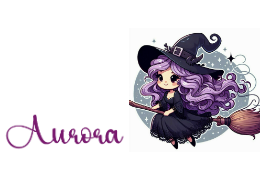
For more seasonal celebrations, check out our guides to Samhain and Imbolc – the holidays that come before and after Yule in the Wheel of the Year.



